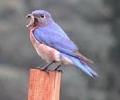Predation of Eastern Bluebird Eggs and Young
by Leif Marking, September 2004
Predators play a major role in decreasing production rates of bluebirds prior to fledging as well as following fledging when the inexperienced youngsters perhaps suffer even greater mortality. Predation in the nest box is easier to quantify because the subjects are confined, but occasionally the reason for mortality or disappearance is not obvious, and you must search for clues. Ants and other chewing insects will leave wounds (lesions) on the nestlings, often on characteristic parts of the body. They are capable of killing nestlings and should be regarded as predators. Avian predators, such as House Sparrows and House Wrens that peck and destroy the eggs, young, and even adults, must be avoided by proper house placement.
Mammalian predators, such as raccoons and cats, generally leave obvious scratch marks to indicate why the eggs or youngsters are missing. Biting insects such as lice, mosquitoes, and black flies can also carry protozoa parasites that cause diseases such as malaria or viruses such as Eastern equine encephalitis or West Nile virus which can have varying levels of effect on nestlings. Disease and toxic chemicals may kill nestlings, and these mortalities are more difficult to assess, especially without professional help for examinations.
I monitored 100 NABS-style bluebird houses this year that were protected with five foot PVC pipes over seven foot steel T-type fence posts with particular attention to quantify predation losses and to encourage maximum production. Those 100 houses, spaced at least 200 yards apart along County Highways S and M in La Crosse County, produced 530 bluebird fledglings and 18 Tree Swallows for a very satisfactory production rate of 5.30 bluebirds per house. However, even better production was prevented in those houses by losses of 26 young to American Kestrels, 15 young to cats, 18 eggs to House Wrens, 10 young to House Sparrows, and 34 young to unknown causes. A total of 103 eggs and young perished in those categories, which represented nearly 20% of the bluebirds fledged.
Those NABS-style houses had oval entries which apparently offer a better opportunity for a kestrel to protrude its head through the entry hole and wait for a young bluebird to rise up to receive a meal. On one occasion I noticed talon marks around the keeper nail used to secure the swinging side panel. Apparently, the keeper nail offered a toehold for the tiny falcon to cling to the house. All the houses that were attacked have been equipped with a round-hole cover plate over the oval hole to discourage kestrel entry. Also, the keeper nail has been moved to the rear of the house to eliminate any traction advantage on the front of the house. This kestrel threat will be monitored carefully next year with hopes to eliminate the attacks with these simple modifications.
The bluebird young dying of unknown causes were usually about 10 days old and growing feathers. Clutches of three, four, or five in nine different boxes seemed to die simultaneously in the presence of parents for no apparent reason. Complete nests with dead youngsters in three cases were sent to the USGS National Wildlife Health Center, Madison, WI for analysis to determine the probable cause of death. Two nestlings from each nest were examined for external and internal lesions or abnormalities, presence of West Nile virus, and histopathology of heart, lung, liver, kidney, spleen, bursa, and intestine. Brain cholinesterase activity was measured for pooled and paired samples of nestlings.
The nestlings were similar in age as their weights ranged from 18.0 to 22.6 grams. The chicks in all three nests were in adequate nutritional condition and showed evidence of recent feedings. Their stomachs (proventriculus and ventriculus) contained moderate to abundant food material, suggesting normal feeding. Abundant feces remained in the lower colon and cloaca. Internal organs were not abnormal. No lesions were seen in the lungs, air sacs, hearts, adrenal glands, thyroid glands, pancreas, or gastric mucosa. No evidence of West Nile virus was found in virologic screening or in gross or microscopic examinations. Brain cholinesterase activity of chicks from each nest was within normal limits, indicating that the chicks had not been exposed to common agricultural or household insecticides. Chicks in all houses had simulid flies (black flies) in nesting material or on the chicks themselves. Mild dermatitis corresponded to the numbers of flies found, and resembled insect bites, but it could not be determined if they were the cause of death. In conclusion, the diagnosis was undetermined cause of death.
Other Wisconsin bluebirders have experienced severe mortalities of nestlings attributed to black fly attacks. Gary Gaard, a bluebird researcher, discovered that black flies are reluctant to enter a dark cavity and demonstrated how to avoid these black fly attacks. They have successfully prevented their entry by simply plugging ventilation openings to create interior darkness or by building new houses without the vents.
Since black flies were present in all nests with dead chicks, I can reasonably assume that black flies were the most probable cause of death. I did not actually recognize black flies around the houses or on the live or dead fledglings because of my inexperience, but I certainly will pay more attention to this kind of mortality in the future. Accordingly, I will darken nest box interiors to prevent or at least decrease future mortalities of nestlings and hopefully increase my bluebird production rate.
I am indebted and grateful to the wildlife disease specialists for their extensive analysis and evaluations of these nestling bluebirds.
Reference: Gaard, Gary. Eliminating Black Fly Feeding on Nestling Bluebirds. Spring 2003, Vol. 18, No.1, P 1-4.


 gmail.com
gmail.com